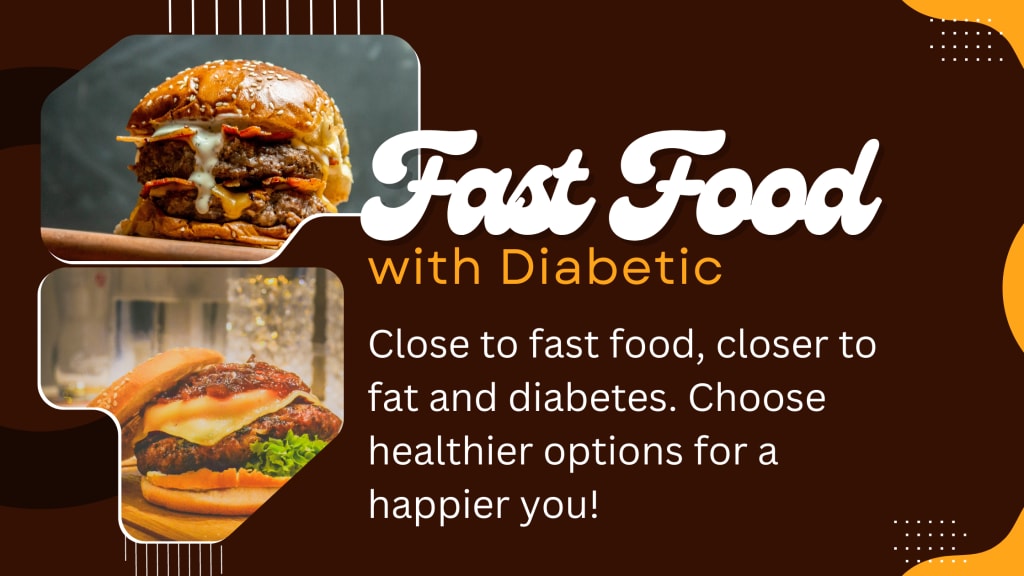Is it simpler to develop fat and diabetes if a fast food establishment is close by?
Close to fast food, closer to fat and diabetes. Choose healthier options for a happier you!

What is Fast Food
Fast food refers to food that is prepared quickly, often served in a ready-to-eat or take-out form, and is typically high in calories, fat, salt, and sugar. Fast food restaurants, also known as quick-service restaurants, are known for their convenience, affordability, and speed of service. Examples of fast food include burgers, fries, pizza, fried chicken, hot dogs, tacos, and sandwiches, which are often served with soda, milkshakes, or other sugary drinks. Fast food is often criticized for its negative impact on health, as it is associated with an increased risk of obesity, type 2 diabetes, heart disease, and other health problems.
Is fast food low in nutrition and high in calories?
Fast food is a quick meal that can be prepared and eaten immediately after ordering. There are various menus such as hamburgers, fried chicken, French fries, pizza, and donuts.
Fast food emerged in the United States in the 1950s and dramatically changed food culture around the world. In Japan, the number of users has increased significantly over the past 30 years.
“The proliferation of fast food has brought cost-effectiveness and time savings, but at the cost of increased consumption of low-nutrient and high-calorie diets,” says Megan McCrory of the Boston University School of Public Health. says.
“Fast food menus have nearly tripled in the last 30 years. Fast food has some healthy options, but overall nutrition, such as calories, size, and salt content, has rather deteriorated.
McRory and his colleagues investigated how fast food affects obesity, and chronic diseases such as type 2 diabetes, and heart disease. The study was supported by the Agricultural Research Service of the US Department of Agriculture and was published in the Journal of the Academy of Nutrition and Dietetics, published by the American Dietetic Association.
According to research, the average calorie intake from today's fast food is 767kcal when adding side dishes to the main menu. Assuming that the average daily calorie intake for adults is 2,000kcal, fast food accounts for nearly 40%. Add high-calorie soft drinks to this, and the calorie ratio rises to 45-50%.
In 1986, 1991, and 2016, the research group investigated fast food usage among Americans by classifying fast food into 1,787 categories. We surveyed the menus of the top 10 fast food chains in the United States, including McDonald's, Dairy Queen, and Kentucky Fried Chicken.
As a result, it was found that the main menu of fast food increased by 30 kcal in 10 years and nearly 100 kcal in 30 years. These are mainly due to the increased portion size.
Not only calories , but also salt (sodium) has been increased in most menus. Over the past 30 years, sodium has increased by 4.6% per day in main dishes, 3.9% in side dishes, and 1.2% in desserts.
Fast food needs to change
The increased calorie and salt content of fast food is undesirable from the perspective of preventing and improving obesity, type 2 diabetes, hypertension, and dyslipidemia.
The increase in obesity and type 2 diabetes has become a serious problem worldwide, and how to improve eating styles has become an issue. “We need to make it easier for consumers to care about their health and make healthy choices,” McRory stressed.
“We welcome the increase in restaurants that display calorie and nutrition information on fast food menus, but there are not enough of them. We need more change."
Change Fast food to Healthy food
It can be difficult to go from fast food to healthy options, but it is definitely possible with little preparation and work. The following advice will help you make the change:
- In advance: Convenience is one of the primary causes for which people choose fast food. Plan your meals and snacks in advance to avoid this. This can assist you in making better decisions and ward off the urge to eat fast food.
- Prepare food at home: Preparing food at home provides you greater control over the ingredients you use and may be entertaining and satisfying. Begin by making enjoyable, straightforward, healthy meals and snacks, and then progressively expand your knowledge of and variety in the kitchen.
- If you do decide to eat out or order takeaway, pick healthier options. Restaurants with salads, grilled chicken, fish, or vegetarian options are good places to look. Choose meals that are high in veggies and whole grains rather than fried or processed items.
- Replace unhealthy foods with healthier ones by making healthier substitutions. Consider substituting whole grain bread for white bread, olive oil for butter, or soda for water or unsweetened tea.
- Smart snacking is choosing fruit, vegetables, nuts, or seeds over unhealthy options like chips or sweets. Have wholesome snacks on hand at home, in the office, or when travelling.
Remember that changing your lifestyle to become healthier takes time and work, so don't be too hard on yourself if you periodically lapse or indulge in fast food. Celebrate your victories as you go along and keep your eye on the prize rather than perfection.
About the Creator
Helan D. Jhonson
Welcome,
I believe that a healthy lifestyle is needed for a happy life, I'm a writer passionate about physical and mental health. Follow me for tips, and inspiration to help you live your best life.
https://welnesswisdom.blogspot.com/
Enjoyed the story? Support the Creator.
Subscribe for free to receive all their stories in your feed. You could also pledge your support or give them a one-off tip, letting them know you appreciate their work.






Comments (1)
Discover the link between fast food establishments and the development of obesity and diabetes in this thought-provoking article. Explore the latest research findings and gain a deeper understanding of how your environment can impact your health. Don't miss out on this informative read!